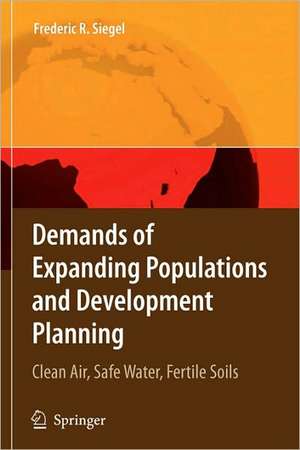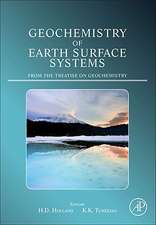Demands of Expanding Populations and Development Planning: Clean Air, Safe Water, Fertile Soils
Autor Frederic R. Siegelen Limba Engleză Paperback – 19 oct 2010
| Toate formatele și edițiile | Preț | Express |
|---|---|---|
| Paperback (1) | 638.11 lei 6-8 săpt. | |
| Springer Berlin, Heidelberg – 19 oct 2010 | 638.11 lei 6-8 săpt. | |
| Hardback (1) | 642.51 lei 6-8 săpt. | |
| Springer Berlin, Heidelberg – 18 aug 2008 | 642.51 lei 6-8 săpt. |
Preț: 638.11 lei
Preț vechi: 750.72 lei
-15% Nou
Puncte Express: 957
Preț estimativ în valută:
122.11€ • 126.77$ • 101.83£
122.11€ • 126.77$ • 101.83£
Carte tipărită la comandă
Livrare economică 22 martie-05 aprilie
Preluare comenzi: 021 569.72.76
Specificații
ISBN-13: 9783642097614
ISBN-10: 3642097618
Pagini: 248
Ilustrații: XX, 228 p. 27 illus.
Dimensiuni: 155 x 235 x 13 mm
Greutate: 0.35 kg
Ediția:Softcover reprint of hardcover 1st ed. 2008
Editura: Springer Berlin, Heidelberg
Colecția Springer
Locul publicării:Berlin, Heidelberg, Germany
ISBN-10: 3642097618
Pagini: 248
Ilustrații: XX, 228 p. 27 illus.
Dimensiuni: 155 x 235 x 13 mm
Greutate: 0.35 kg
Ediția:Softcover reprint of hardcover 1st ed. 2008
Editura: Springer Berlin, Heidelberg
Colecția Springer
Locul publicării:Berlin, Heidelberg, Germany
Public țintă
ResearchCuprins
The Ecosystem and Development.- Populations: Growth, Braking, Contraction.- Population Needs for Well-Being.- The Surface/Near-Surface Atmosphere.- Water: An Essential, Limited, Renewable Resource.- Soil Formation, Quality, Sustainability.- “Green” Legislation: Now for the Future.- Proactive Planning in Industrial/Agricultural Development: Minimizing Chemical Pollution.- Remediation/Reclamation Options for Polluted Environments: Feasible or Not.
Notă biografică
FREDERIC R. SIEGEL is Professor Emeritus of Geochemistry at the George Washington University. His books Applied Geochemistry (1974), Geoquimica Aplicada (1992), Natural and Anthropogenic Hazards in Development Planning (1996), and Environmental Geochemistry of Potentially Toxic Metals (2001) reflect Dr. Siegel's cumulative teaching and research experiences. These are in general, marine, exploration, and environmental geochemistry in several countries, and in practices that alleviate or eliminate environmental problems related to physical, social, chemical, and economic conditions where development projects are being planned.
Textul de pe ultima copertă
This book brings together three topics that interact to affect the quality of life on Earth. First, it examines expanding populations (and contracting ones) in regional and national contexts. Second, the book reviews the impacts of pollution on people, ecosystems and economic ventures. The rate of population increase is slowing but growth momentum is projected to carry the Earth's population from >6.6 billion in 2007 to 9.2-11 billion inhabitants by 2050. Vast numbers of today's world population, mainly in less developed or developing nations, suffer illnesses from chemical or biological pollutants in the air they breathe, the water they drink, and the foods they consume. Millions die. What then can be expected for a 50% larger population by 2050? Third, the book asserts that well-planned development projects adhering to environmental laws and with best available technologies, will reduce ecosystem pollution yet yield strong profit margins. Proactive project design will also carry social development aims such as in education, job creation, and healthcare. The text includes examples of pollution from human activities and reviews solutions to alleviate or eliminate them.
Caracteristici
Includes supplementary material: sn.pub/extras









